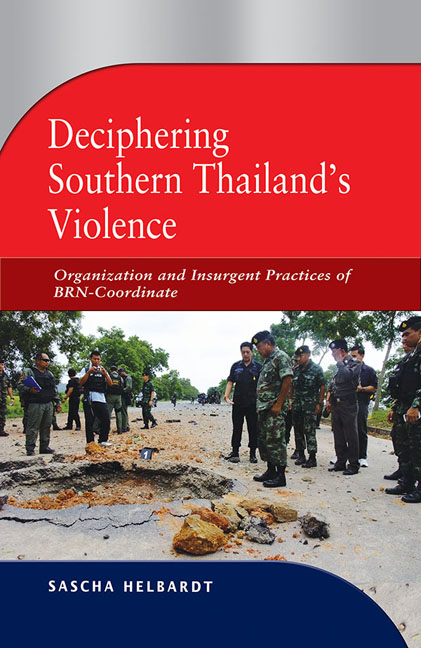Book contents
- Frontmatter
- Dedication
- Contents
- List of Figures
- List of Abbreviations
- Preface and Acknowledgments
- 1 Introduction
- 2 Organizational Aspects of BRN-Coordinate
- 3 Making Insurgents: Recruitment, Training and Control
- 4 Bringing the Actors Back In: Who Are the Insurgents?
- 5 Making Sense of Violence: Power and the Insurgency's Communicative Side
- 6 Conclusion
- References
- Bibliography
- About the Author
- Frontmatter
- Dedication
- Contents
- List of Figures
- List of Abbreviations
- Preface and Acknowledgments
- 1 Introduction
- 2 Organizational Aspects of BRN-Coordinate
- 3 Making Insurgents: Recruitment, Training and Control
- 4 Bringing the Actors Back In: Who Are the Insurgents?
- 5 Making Sense of Violence: Power and the Insurgency's Communicative Side
- 6 Conclusion
- References
- Bibliography
- About the Author
Summary
When the Thai government and BRN-Coordinate, a Malay-Muslim separatist group active along Southern Thailand's border, signed an agreement to hold peace talks in Kuala Lumpur on 28 February 2013, it came as a surprise to most observers. The Yingluck Shinawatra government never seemed particularly interested in the Malay-Muslim insurgency that had been raging along its border with Malaysia since 2004 and had cost the lives of almost 6,000 people. The former minister of interior and deputy prime minister, Chaloem Yubamrung, responsible for the restive region, had hardly travelled there during his term of office and Yingluck herself only made very general remarks about the South. As was the case for most governments since 2004, the Yingluck government appeared content to leave the mandate for major political strategies as well as for the counter-insurgency campaign primarily with the Thai security forces. Many observers were of the impression that as long as the conflict remained outside of Bangkok or the valuable tourist areas in the South, the government would never place it high — if at all — on its agenda. The government's lackadaisical attitude changed abruptly in early 2013, when the Thai government suddenly seemed very determined to take some kind of action.
The announcement was equally surprising given that despite the fact that the insurgency in Southern Thailand remains one of the bloodiest in Southeast Asia, no group had ever taken credit for its outbreak in 2004. BRN-Coordinate was hardly well-known globally. Although the Malay population in the South were familiar with the name BRN-Coordinate,1 even scholars, journalists, and the majority of Thai government officials have very limited knowledge about the organization's structure and its overall role in the unrest.
Since violence broke out in Thailand's Malay-Muslim-dominated South in 2004, little information has been garnered about the perpetrators of these violent acts, as the description and the interpretation of data is impeded by a cloud of “nameless” violence that renders an understanding of the definition of actors, their organization, and their interests difficult. Furthermore, even though scientific observers, state agencies, and the local population are attempting to make sense of these violent acts, they all face the problem of uncertainty: Who are the perpetrators of violence on the “Malay side”? What are their motives? Are they simply the victims of harassment or the failed policies of the Thai nation state who respond with a bloodstained campaign of revenge?
- Type
- Chapter
- Information
- Deciphering Southern Thailand's ViolenceOrganization and Insurgent Practices of BRN-Coordinate, pp. 1 - 26Publisher: ISEAS–Yusof Ishak InstitutePrint publication year: 2014

